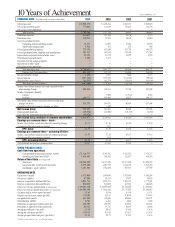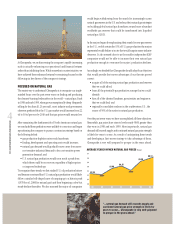Chesapeake Energy 2004 Annual Report Download - page 11
Download and view the complete annual report
Please find page 11 of the 2004 Chesapeake Energy annual report below. You can navigate through the pages in the report by either clicking on the pages listed below, or by using the keyword search tool below to find specific information within the annual report.
CHESAPEAKE ENERGY CORPORATION ANNUAL REPORT 2004
7
between $10 million and $600 million, we have confidence that
more acquisitions in that range will remain an attractive aspect of
our business strategy.
FOCUSED ON EXPLORATION
For much of the past 20 years, the E&P industry has been a tough
place to make a living. The industry has been handicapped by low
prices, accelerating depletion rates, increasing finding costs, a
shrinking labor pool, rising environmental opposition and more
costly governmental regulations. It is a wonder the industry survived
at all. Not surprisingly, investors ignored the E&P industry, choosing
instead to focus their investments on energy-consuming industries
that were the beneficiaries of our industry’s tough times.
Today’s E&P industry is comprised of a relatively small number of
resilient companies that survived through a long period of low oil
and natural gas prices by being financially and operationally
conservative. We believe this conservatism has caused many of our
peers to be overly cautious in increasing drilling activity in response
to prices that have risen steadily during the past seven years. For
example, even though oil and natural gas prices have increased
six-fold from their 1998 and early 1999 lows, drilling activity has
increased by less than three-fold.
As a consequence, U.S. natural gas production in 2004 decreased
for the fourth consecutive year. Perhaps more worrisome, the industry
has been trending away from searching for new gas reserves through
exploratory drilling in favor of drilling infill wells that are designed
to drain known gas reserves more quickly. This trend reflects a
natural reaction to an extended period of low oil and natural gas
prices and a common skepticism about the longevity of today’s
higher prices. “Harvest it while you can before prices decline again”
is still a view widely held by industry management, analysts
and investors.
On the other hand, Chesapeake has adopted a different approach.
We have invested more than $1.3 billion in acquiring leasehold and
3-D seismic information during the past four years, enabling our
employees to develop large numbers of developmental and exploratory
drilling prospects from the largest onshore inventories of 3-D seismic
and leasehold in the industry.
Some of our exploration opportunities target deep natural gas
reservoirs at depths of 15,000-23,000 feet, while others test various
unconventional gas resource ideas. Successful exploration has been
a key reason for our ability to generate industry-leading organic
growth rates of 18% in 2003 and 20% in 2004. We are optimistic
the projects targeted for exploratory drilling in 2005 will be successful
and will enable us to exceed our projected organic growth rate of 10%.
FOCUSED ON EMPLOYEES
Another key ingredient of Chesapeake’s success has been the
investment we have made in strengthening our employee talent
pool. Seven years ago, when we overhauled the company’s business
strategy, we identified the elements coming together for stronger oil
and natural gas prices and began to build the foundation of natural
gas assets and drilling upside that characterize the company today.
To accomplish these goals, we
recognized we would need a
deeper and broader pool of
employee talent and over the past
seven years, we have increased the
number of our employees from
500 to 1,900. Approximately 1,600
work in our E&P operations
while another 300 work in our
midstream gas and drilling rig
subsidiaries. We have primarily focused on strengthening our land,
geoscience and engineering departments, areas where we anticipated
shortages of skilled labor would become increasingly acute as
the industry began ramping up drilling activity in reaction to
higher prices.
A particular focus of Chesapeake’s hiring during the past few years
has been the identification of young talent and our success in
attracting them to join our rapidly growing company. Since the
industry’s last hiring boom of the late 1970’s and early 1980’s, there
have been very few reasons for young people to join this industry.
In most E&P companies today, the average age of senior landmen,
geoscientists and engineers is over 50, making our industry one of
the oldest in the country.
“A particular focus of Chesapeake's hiring during the
past few years has been the identification of young
talent and our success in attracting them to join our
rapidly growing company.”
00
462
01
677
02
866
03
1,192
04
1,718
3/05
1,930
EMPLOYEE
GROWTH























